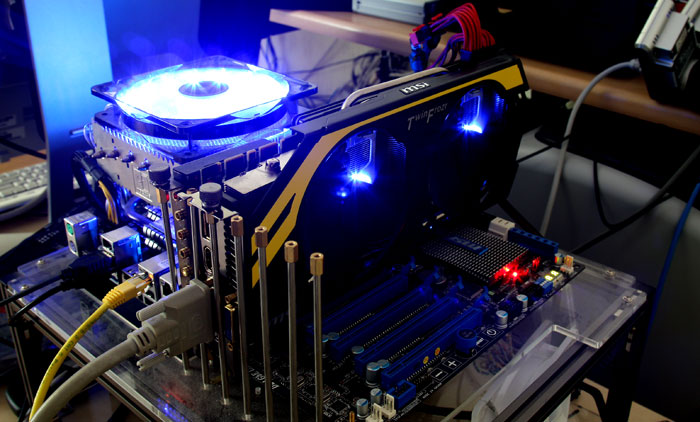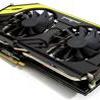Final words and conclusion
Final words and conclusion
The MSI Lightning is an impressive beast that will need some further exploration once AfterBurner is ready to deal with the new digital voltage circuitry. The current power limitation is 200% and might also be raised to 300% from what I've heard. But that is what it is, so for now we'll have to focus with what we have at hand. Overclocking wise expect to reach roughly 1300 MHz with the current software based on the boost frequency. Once voltage control is opened up 1400 MHz is our next aim ;)
The MSI GeForce GTX 680 Lightning is a very interesting product. The only thing original on the card is the GPU, MSI redesigned the rest from scratch. The PCB, the voltage circuitry, the usage of gold coated solid state chokes, copperMOS and nickel plated capacitors are just a simple indication of that.
It stretches well beyond PCB design and components usage though as the product also comes with that GPU reactor, we do have some doubt about the actual benefits from the Tantalum capacitors that are used to filter and stabilize GPU voltage but we surely do like them on there.
The GTX 680 Lightning has it all, the looks, the very nice factory overclock, the (relatively) low power consumption, downright excellent noise levels and obviously the performance to play any game really well.
That factory overclock is pretty significant, the reference products are all clocked at 1006 MHz and this card comes with a factory clock set at 1110 MHz. Typically you'd figure that factory overclock result in added heat and noise but the reality remains that the new Twin Frozr IV cooler makes the 680 Lightning an inaudible graphics card (under gaming conditions), temperatures actually stay under 60 Degrees C (under gaming load) which is splendid. Power consumption as well impressed us, with the GPU at 100% load our X58 Core i7 based AMD test PC was consuming roughly 300~350W. When we input the variables and reverse calculate the TDP, we end up at a score of give or take 183W for this graphics card, and that's noteworthy.
Gaming wise obviously you will not have anything to complain either, all modern games play perfect up-to at least 1920x1200 and higher. The 2GB memory is nice, but realistically only comes into play once you start to setup multiple monitors, that's where memory starts to matter. So we did hope the card would have been 4GB being at this enthusiast level, but perhaps an extreme edition will be released with some extras like an added 2GB of framebuffer.
The performance level however is excellent and more than enough for the enthusiast gamer with a monitor up-to 1920x1200, and much like the reference model we still have a smile on our face when we look at its low power draw. If you game at 1920x1080/1200 then this is a product we can very much recommend. Good performance, good looks with a nearly inaudible product (based on gaming).

We have to applaud the noise levels as well -- with one remark -- when you startup the PC you'll get scared quite a bit as the noise is loud. That's anti-dust technology at work actually. The two fans rotate in reverse real hard for a while to remove dust from the fans and cooling fins. After 30 seconds the fans will start to rotate normal again, and once booted into Windows (with the NV driver loaded) the noise levels drop to completely silent. So during boot up the card definitely is noisy, but only during the PC boot phase.
Once you reach your Windows desktop the fans will rotate at their normal RPM and we measured a 37~38 DBa noise level in the test room at 75 CM distance from the card. That very hard to hear in normal conditions. Even during gaming you'll find it hard to hear the card (under the condition that you have properly ventilated your chassis). Note that if you think that 60 Degrees C during gaming is still not chill enough for you then you may fool around with fan RPM a little yourself, you'll get a good impression of how much cooling capacity the card really has. But yeah, then noise levels will rise quickly as well.
As mentioned quite a bit in this review, the card comes factory overclocked for you. The GPU core has been set a good notch higher, overall resulting into a slight boost in performance compared to the reference products. With any GTX 680 review I mention it, the Dynamic Clock Adjustment (boost) technology remains a little weird to observe, it however is a clever trick for the card to clock a little higher when the power envelope justifies it. The MSI GeForce GTX 680 Lightning edition baseclock is 1110 MHz (1006 MHz = NV reference) and the "Boost" clock at 1167 (1058 MHz reference) gives the card way more headroom to play with.
The end result is a card that performs well, there's not a game out there that it can't deal with. Anno 2070 at the best quality settings and 4xAA pushes near 100 frames per second on average at 1920x1200, and still 60 fps at 2560X1600. In Crysis 2 we end at an average of 66 FPS in 1920x1200 with Ultra quality settings and that high resolution texture package and 4x AA. Battlefield 3 is another example, with all eye candy opened up in game and again at 4xAA the card still pushes 59 FPS at 19x12 and that makes it the amongst the fastest single GPU based graphics card on the market.
The 28 nm Kepler transition also brought a better power envelope towards the card. The board power is rated at 195 Watt. Our measurements have shown that (while gaming) we use roughly 183 Watt, and that's for a factory overclocked model. The idle power consumption of the card we calculate to be roughly 10~11 Watt. Based on historic data we collect the idle power consumption was the lowest ever for a PC with a dedicated card installed and the monitor activated.
Worthy of mentioning is that currently there is still a problem with GeForce GTX 600 drivers, with VSYNC enabled people have been noticing weird stutter behavior. NVIDIA promised to get this resolved asap with a new driver update. New Beta's already have shown improvement though it seems NVIDIA still does not have the issue fully under control.
It's good to see that the GTX 680 now supports gaming with three monitors with one card, here we do think that 2 GB of graphics memory would be on the shy side though. The MSI GeForce GTX 680 Lightning edition is so new that it has not been spotted in the stores just yet. We expect it's price to be in the 525 EUR marker which is a lot of money to play games on your PC alright. The reality remains that the MSI GeForce GTX 680 Lightning edition is  amongst the fastest retail GeForce GTX 680 cards we tested to date. While doing it's magic it remains absolutely silent while it is only a two slot design. We'll still have to wait and see how much tweaking potential the card really has once the overclock software supports voltage tweaking outside NVIDIA's set limits, right now we hit a wall at roughly 1300 MHz which is not bad, but we know the hardware can do much better.
amongst the fastest retail GeForce GTX 680 cards we tested to date. While doing it's magic it remains absolutely silent while it is only a two slot design. We'll still have to wait and see how much tweaking potential the card really has once the overclock software supports voltage tweaking outside NVIDIA's set limits, right now we hit a wall at roughly 1300 MHz which is not bad, but we know the hardware can do much better.
Regardless, the MSI GeForce GTX 680 Lightning is a card that is simply fantastic to look at, great to play with and it remains silent and cool while doing so. A very nice card which comes recommended by Guru3D.com
Update: we posted a snippet on voltage tweaking right here.
- Leave/read comments on this product
- Sign up to receive a notice when we publish a new article
- Or go back to Guru3D's front page

